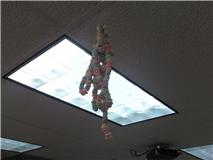COLLAGEN STRUCTURE AND FUNCTION
1. Describe the primary structure
of collagen. What are the major amino acid components? Collagen is composed of
three chains, wound together in tight triple helix. Each chain is over 1400
amino acides long. Every third amino acid is gycine, many remaining positions
in the chain are filled by proline and a modified version of proline which is
hydroxyproline.
2. What role does vitamin C play
in collagen formation? What happens when a person does not get enough vitamin C
in his or her diet? The reaction requires vitamin C to assist in the addition
of oxygen. If we don’t get enough Vitamin C in our diet it slows the production
of hydroxyproline and stops the construction of new collagen. This causes
scurvy.
3. Describe the quaternary
structure of collagen (the way in which the polypeptide chains are arranged). Polypeptides are arranged in a way that
it is a straight chain in a pattern.
Part 2.
Read the material in the sections
entitled "Facts on Osteogenesis Imperfecta” and “Types of OI.” Use what
you have learned to answer the following questions:
1. What is the main symptom of
osteogenesis imperfecta? What are
some other symptoms that people with OI may have? The main symptoms of OI are muscle weakness, hearing
loss, fatigue, joint laxity, curved bones, scoliosis, blue sclerae,
dentinogenesis imperfecta (brittle teeth), and short stature. Other symptoms of
OI are easy bruising and bleeding and breathing problems.
2. Type I osteogenesis imperfecta
causes fewer problems than the other forms. How does the collagen structure in
Type I OI differ from that of the other types? The collagen in type 1 is
different from the other types of OI because in type one the collagen is
normal.
Read the handout in the resources
section on Bone Structure (opens in Acrobat Reader).
1. Describe the role of collagen
in bones. Why do collagen problems lead to bone problems?
collagen is a main part of the bone if something goes wrong with it then
the bone will have problems.
